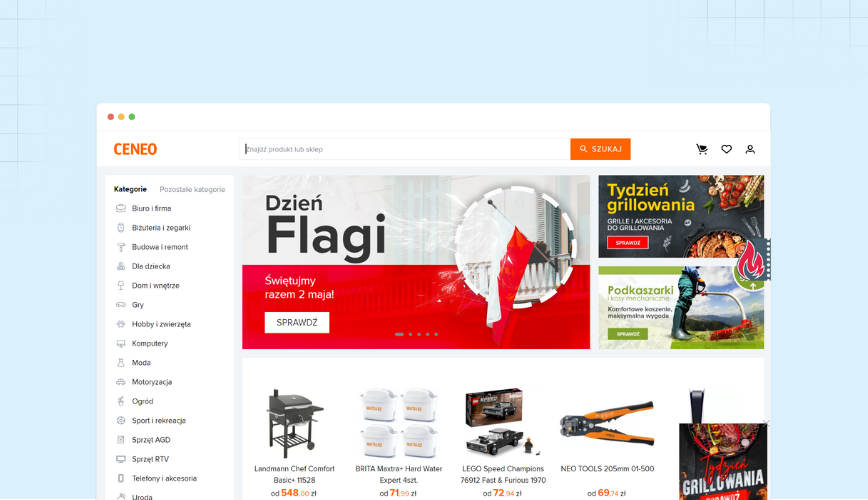Businesses primarily rely on sales, profit, and market share to evaluate their performance. In e-commerce, category management refers to managing product assortment, sales, and turnover for a product category, and each category is considered a separate business unit. Therefore, an e-commerce company’s key performance metrics — sales, profit, and market share — are measured and evaluated separately for each category, under the direction of a category manager.
However, measuring only these KPIs does not give the full picture of performance. This data is not enough to understand exactly how and at what expense a category can be scaled.
In this article, we offer a comprehensive approach to assessing the state of a particular category and the market as a whole to improve your understanding of market dynamics and help you find areas for category growth.
Contents:
Key Internal Indicators for Category Analysis
Additional Data Sources — Market Analysis
Advantages of a Comprehensive Approach to Category Assessment
Key Internal Indicators for Category Analysis
If you find yourself in a hole, stop digging is a famous saying that aptly describes the importance of KPI tracking. Category KPIs help the category manager understand whether they’re in a hole.
Here are six KPIs to help you assess the status of a category and potential ways to grow.
- Category turnover indicates a category’s sales dynamics, as measured by the amount of revenue over a certain period of time. Simply put, it’s how much you made on your product in a month, quarter, year, etc.
- Gross profit by category is the main indicator for the category manager (since other types of profit are also affected by other departments). A high gross profit by category suggests an optimal assortment, well-chosen suppliers, and an effective pricing policy.
- Gross margin is the profit you make from the selling price of a particular product.
- GMROI (Gross Margin Return on Inventory Investment) is your gross profit from investments. It is one of the best metrics for measuring and managing the performance of your inventory investment. GMROI shows how much the company earned from a product compared to the amount it invested in purchasing the product. For example, if GMROI is $30, it means that from every dollar invested in the product, the profit was $30.
- Inventory turnover ratio shows how many times a company turns over its inventory within a certain period of time. That is, this indicator gives an idea of how effectively the category manager manages inventory.
- Availability of goods makes it possible to determine how many goods from the current assortment matrix are in stock and available for ordering in the online store.
You can learn more about how these indicators are calculated and how to correctly set KPIs for a category manager in our article on the top 6 KPIs for a category manager and dashboards for tracking.
Important! Key performance indicators for a category must be regularly monitored, analyzed over time, and evaluated in terms of conformance to the plan.
Additional Data Sources — Market Analysis
A lack of analytical data is a limiting factor in the work of category managers, as it impairs the ability to adequately assess the state of the category compared to the market. Therefore, in addition to internal indicators, when forming a category scaling strategy, it’s worth analyzing additional external data sources.
Pricer24
Pricer24 is a cloud-based platform that provides market analytics and helps you find insights in the changing e-commerce environment. Among Pricer24 clients are such companies as Philips, ASUS, HyperX, Gigabyte, MSI, Ajax Systems, TP-Link, Rozetka, and Comfy.
With Pricer24’s real-time reports, you can benchmark prices and assortments to understand how your pricing and product offerings compare to your competitors’ prices and assortments. This helps you identify opportunities to optimize pricing and product presentation.
GFK
GFK is an international company that provides comprehensive market analysis through market research, sociological surveys, and reports. GFK works with over 100,000 partners tracking over 10 million SKUs.
GFK’s reports are useful for understanding retail development trends, changes in consumer behavior, sales conditions, and price levels in global, regional, and local markets. For more effective market analysis, the company offers a subscription to the gfknewron platform, which combines information about the market, users, and brands with predictive analytics and recommendations based on artificial intelligence.
Euromonitor
Euromonitor is a world leader among independent companies specializing in international strategic research of consumer markets. Their data enables category managers to gain a comprehensive view of the values, behaviors, and preferences of end consumers. For example, in a recent Euromonitor report, you can find out what consumers expect from brands in 2025.
IDC
IDC is another international consulting company that conducts marketing research. IDC specializes in analytics for IT products, telecommunications, and consumer electronics. Depending on the categories you manage, IDC’s reports, white papers, and webinars on the state of and trends in the technology industry will be worth checking out.
Reports of leading international analytics companies can usually be downloaded from a company’s website.In these reports, you can easily find information about market leaders in terms of sales, their market share, distribution of sales across different channels, types of stores that sell their products, demand trends, and market volumes for a certain period.All of this is an important part of your category analysis, which will help form a helicopter view.
Data from distributors and vendors
Your partners have important information about:
- sales of your products on the market
- the market share of sellers they work with
- trends, new products/models, and product release dates
- goods that are at the logistics stage in the region in which you work
- products that are running out of stock
Therefore, information from partners is another important source of insights into the movement of products in a category and their popularity on the market.
Open government data
Information from open government sources, such as customs databases for the import of goods, provides an opportunity to estimate the volume of products imported into a country.
Advantages of a Comprehensive Approach to Category Assessment
A comprehensive approach to analyzing internal data (category KPIs) and additional data from external sources is an important stage in the formation of your online store scaling strategy.
Combining and comparing internal and external data allows you to:
- Understand your own market position and dynamics of a category’s performance in relation to the market. Is performance above, equal to, or below the market average? After all, guided only by internal indicators, you may conclude there has been constant growth of the reporting category (for example, sales doubled in a year). But if the market tripled during the same period, growth of your category was actually lower than the market dynamics.
- Evaluate the category’s business potential. There is always an upper bar of market volume or control share above which it is extremely difficult for a business to jump. This applies to stable categories, however: not innovative or new categories, where there is no upper threshold yet.
- Set realistic goals for the category: By how much and in what period should your KPIs grow, taking into account market dynamics?
After you’ve formed your goals, you can proceed to developing a strategy for working with the category. In the following articles in our how to scale an online store series, we will reveal three key areas you need to work on:
- Creating strategies for working with competitors
- Establishing fruitful partnerships with suppliers
- Creating value based on an understanding consumer demand and needs
Conclusion
A comprehensive approach to analyzing category KPIs and market data allows the category manager to better understand the state of a category, identify growth points, and determine the optimal development strategy and action plan to achieve set goals. Monitoring and analyzing these indicators over time is necessary for constant reassessment and adaptation of the category’s development strategy.









